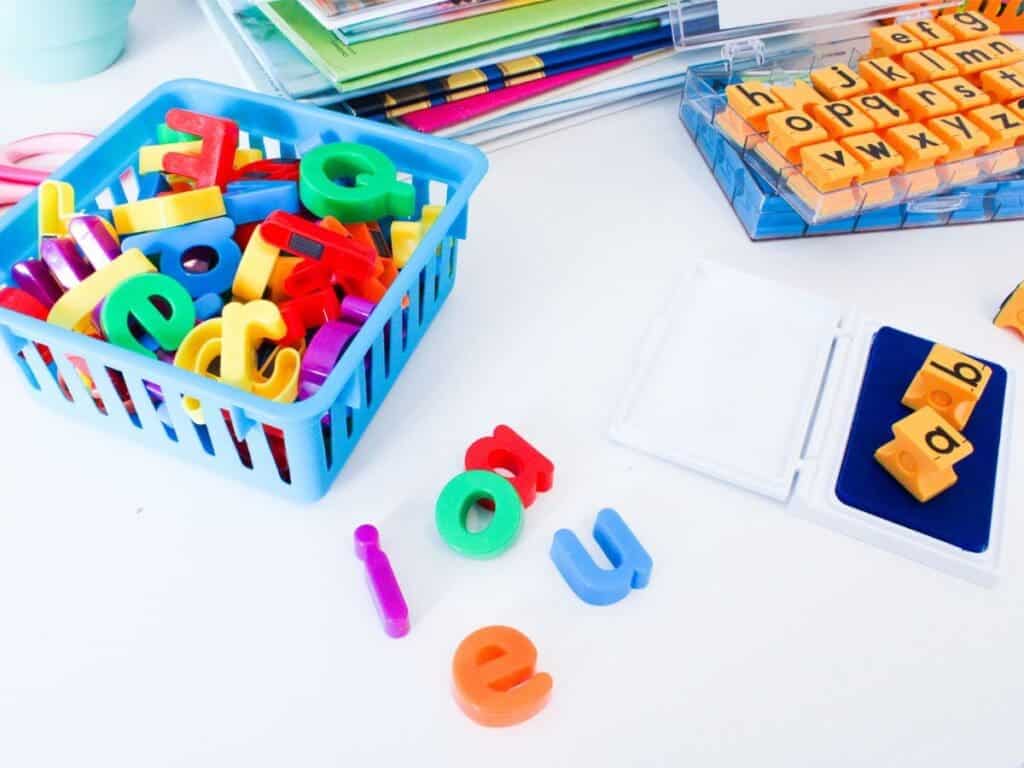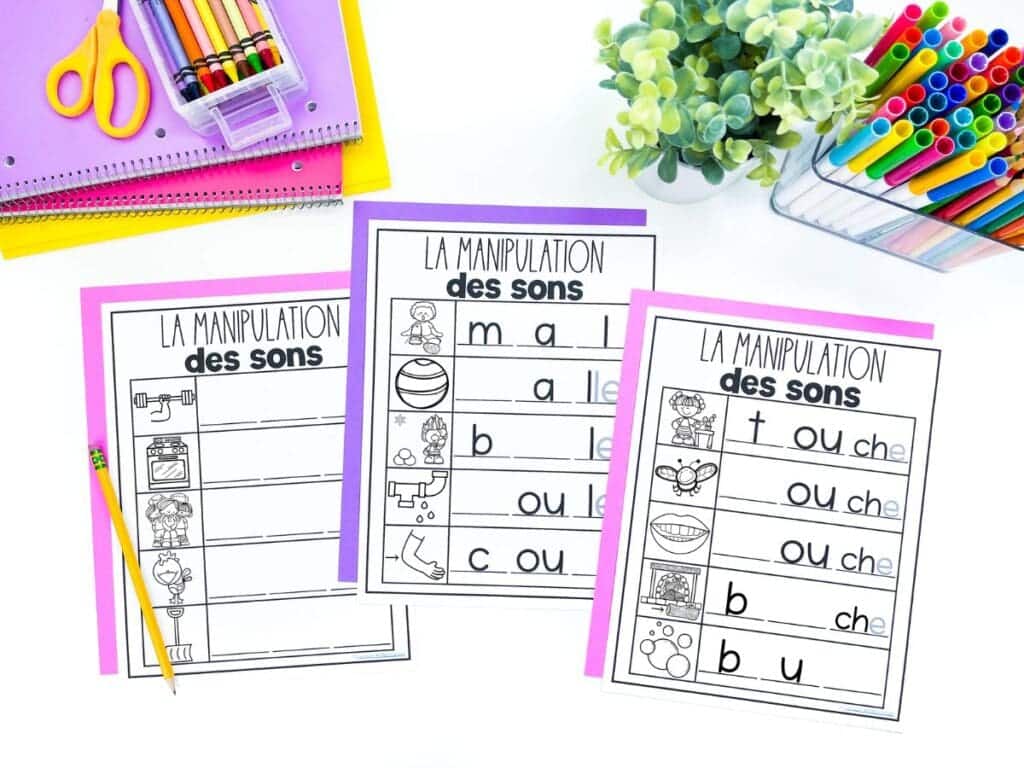
How to use Phoneme Manipulation to Transform your French Literacy Block
Let’s explore French phoneme manipulation, including addition, subtraction, and substitution and how you should teach these concepts to your students.
Teaching your students to learn new words French words is challenging. Simply being able to spell out the letters isn’t the same as saying the word aloud. Thankfully, you can use phonemes to teach students how to pronounce new words based on their existing vocabulary.
Phonemes are the smallest units of sound. Think /p/ as in “papa” or /s/ as in “soupe.” Your students start learning French by identifying these phonemes and parsing them out in their heads. But identifying phonemes is only step one. The next step (at least, according to the French science of reading) is phoneme manipulation.
Here, we begin to add, delete, or substitute phonemes to make new words. That’s what words are – a combination of phonemes.
What is French Phoneme Manipulation, and Why Is It Important?
Phoneme manipulation is precisely what it sounds like. It involves altering phonemes, the smallest units of sound, to create new words. French has 36 different phonemes. There are three options for creating new words: adding, removing, or substituting phonemes.
You might be wondering why we teach French in this way. There are a couple of good reasons:
- It helps understand word structure.
- It builds reading and writing fluency.
- It teaches children to decode unfamiliar words.

Even as adults who speak fluent English, we sometimes come across words that are difficult to say or read. (I’m looking at you, “pneumonoultramicroscopicsilicovolcanoconiosis.”) Manipulating phonemes to make new words covers everything from different tenses to prefixes and suffixes.
For example, a student who can read “balle” (ball) might encounter the word “bulle” (bubble) and recognize that it differs by only a single phoneme. Using their previous knowledge, they can substitute different phonemes and pronounce new words correctly.
So why is this important? Well, even an expert in the French science of reading can’t teach children every word in the dictionary. Things move a lot quicker when children can decode words for themselves – going from learning maybe a handful of words per day to becoming familiar with dozens.
According to the Kirkpatrick (2015), “phonological manipulation tasks are the best measures of the phonological awareness, skills needed for reading because they are the best predictors of word-level reading proficiency”. French phoneme manipulation (adding, deleting, and substituting) is the layer of phonemic awareness that is the most closely related to the ability to read and connect text.
Phoneme Addition
Phoneme addition involves adding a phoneme to a word – often at the beginning or end. The resultant word can be linked to the first word, such as changing the tense or creating an entirely new word.
This skill is the first step in phoneme manipulation. It’s an essential stepping stone for more complex tasks like phoneme deletion. For example, going back to our previous word, “balle,” adding /on/ to the end transforms it into “ballon”. Teaching phoneme addition helps students understand how words can change and expand.
Students can get a little confused at first; therefore, use clear prompts. Say “Dis balle, maintenant ajoute /on/ à la fin,” prompting students to provide the new word, “ballon.” You don’t give students the answer; instead, they connect the dots and provide the word themselves. Repeated practice with such prompts will solidify their understanding and ability to manipulate phonemes.

Phoneme Deletion
Phoneme deletion or removal involves taking a phoneme away from a word. As before, this is usually at the beginning or end (as this is easiest to understand) but can be at any point in the word.
For example, “blanc” becomes “lent” when the /b/ is removed. You can use prompts like “Dis blanc, maintenant enlève le /b/ au début, and then ask students what the new word is. You can give them a little help if they’re struggling; however, don’t just give them the answer. It’s crucial that they work it out for themselves.
More complicated examples of phoneme deletion involve removing a phoneme from within the word. Take the word “grenouille”. Removing the phoneme /r/ from the middle results in “genouille” (although “genouille” is not a standard word in French, it demonstrates the complexity of phoneme deletion).
Phoneme Substitution
Phoneme substitution is the hardest form of phonemic manipulation to master. It requires a student to use working memory to recall a word, break it down into its phonemes, replace one, and then blend the phonemes back together to form a new word. For example, changing the /c/ in “coule” to /b/ results in “boule.” The new words usually have little to do with your initial starting word.
Don’t jump in at the deep end. Begin with simple words that have only 1-3 phonemes, such as changing “le” to “la.” Once they’ve mastered the basics, you can begin to substitute phonemes at the beginning or end of the word first.
As students continue to become more proficient, the examples should become more and more complex, including substituting phonemes in the middle of words. For instance, changing the /a/ in “sac” to /e/ to form “sec.”
Effective Strategies for Teaching Phoneme Manipulation
Saying the phoneme changes aloud is only one part of the teaching. It also helps to see the changes visually on a whiteboard. After all, your students are likely a mix of visual and auditory learners. Some students may find it challenging to grasp the concept without seeing it.
That’s why I love using these French phoneme manipulation worksheets that come with visuals to help students. Once they’ve practiced the skill with only alphabet sounds, then we move on to activities that include digraphs and trigraphs.

In addition, you can incorporate manipulatives like sound cards during small group instructions. They’re a brilliant warm-up activity during the French block with the whole class or as part of small group sessions.
Don’t think you have to spend hours on phoneme manipulation. In fact, it’s probably counterproductive. Short, focused sessions of 5-10 minutes are sufficient to accelerate your student’s learning. Instead, go for little and often – integrating phonological awareness activities into the daily schedule, whether in small groups or as a whole class. Such continual reinforcement drives impressive results.
When the majority of the class has achieved a certain level of proficiency, you can move on to the next skill. However, continue to support those who need extra practice in small groups.
Through consistent, repetitive learning, your students will come on leaps and bounds, performing French phoneme addition, subtraction, and substitution like a pro.
Want to check out the resources listed?
All the links above lead to TPT, but the resources are also available on our website. Here are the resources available here for purchase in CAD. Don’t forget you can also buy credits for an additional discount (up to $15 off).
- Read more about: Blog Feed, Literacy, Primary, Science of Reading
You might also like...
find what you need
Browse by Category
Looking to do some phonics based shared reading?






